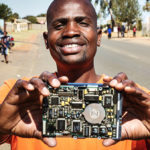 This post was guest-written by Reshma Saujani, the Founder and CEO of Girls Who Code, a national nonprofit organization working to close the gender gap in technology and change the perception of programmers.
This post was guest-written by Reshma Saujani, the Founder and CEO of Girls Who Code, a national nonprofit organization working to close the gender gap in technology and change the perception of programmers.
Originally, Girls Who Code was an experiment with a single mission: to close the gender gap in technology. In its first year, we taught a group of 20 girls to code in one classroom in New York City. Fast forward to today, and Girls Who Code is a national movement that will reach 50,000 girls in all 50 U.S. states by early 2018.
The computing and technology job market is growing faster than ever, but we are leaving our girls behind. At a time where technology is changing everything about the way we live and work, fewer than 1 in 5 computer science graduates are women.
And the gender gap is only growing.
What is the Bravery Deficit?
When I talk to Girls Who Code teachers, they often tell me the same story: During the first week of classes, when girls are learning how to code, they’ll inevitably hear their students say, “I don’t know what to write.” They’ll look at a student’s screen and assume she hadn’t spent any time on the assignment at all.
But with a few presses of the undo button, she’ll see that her student actually wrote code — and then unexplainably deleted it. She tried, came close, but didn’t get it exactly right. Rather than share the progress she’d made, the student deleted what she perceived to be a mistake.
Why? Because we raise our girls to be perfect, and our boys to be brave.
This “bravery deficit” is why I believe women are underrepresented in science, technology, engineering, and math (STEM) careers, in boardrooms, and in many other industries. Even when women are ambitious, they take fewer risks in their careers. So those 600,000 open jobs in computing and tech?
Women have the intelligence and skills to fill them. But without an expanded STEM talent pool that includes women, our economy is missing an opportunity to advance innovation and solve global problems.
Together, for change
The gender gap in technology is one of the most important social issues of our time — an issue we must all come together to solve. Companies like Cisco are making strides in this area.
On March 7, more than 15,000 global employees came together for Cisco’s annual Women of Impact Event, where they discussed this very issue around the theme, “Together for Change.” It was a day dedicated to supporting one another and working together toward positive change. Not just for themselves, but for the young women and future generations who deserve the same opportunities as their peers.
At this year’s event, Mary Elizabeth McCulloch — founder of Project Vive, and the grand prize winner of Cisco’s 2017 Global Problem Solver Challenge — spoke about using technology for social impact and inspiring student entrepreneurs around the world. Mary Elizabeth shared her story of how she started Project Vive, which makes a speech-generating device for people with disabilities.
While completing a year abroad in Ecuador, Mary Elizabeth volunteered in an orphanage for children and adults with disabilities, and that’s when she saw the dire need for accessible, assistive technology. Using her background in biomedical engineering, Mary Elizabeth helped create a device and launched a humanitarian effort to improve the lives of people with nonverbal communication disabilities. Her company’s innovation empowers individuals and allows them to participate, advocate, and break the stigma around disabilities.
Imagine if Mary Elizabeth hadn’t taken that risk; what if she had been too scared to fail, and didn’t try at all?
It’s stories like Mary Elizabeth’s that show us why conversations like today’s are so important. Women’s innovations are and can be catalysts for change. I encourage you on International Women’s Day to think about how you will drive this innovation, whether it’s mentoring girls and women to persist and succeed in technology or joining the conversation using the #IWD2018 hashtag.
Together, we can to begin to undo the culture of perfection and combine it with building a sisterhood that lets girls know that they can be and create anything and everything.
—
Follow Reshma Saujani: @reshmasaujani
Learn more about Girls Who Code: https://girlswhocode.com/
This blog was created as part of a paid partnership.


CONNECT WITH US